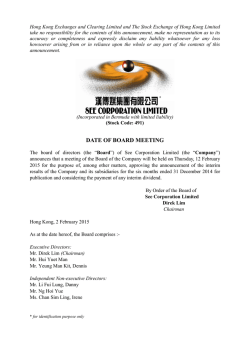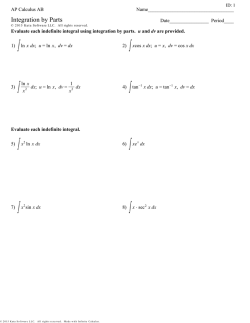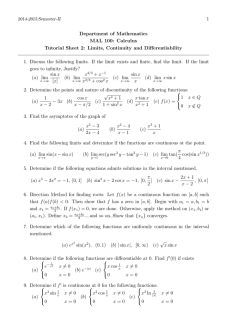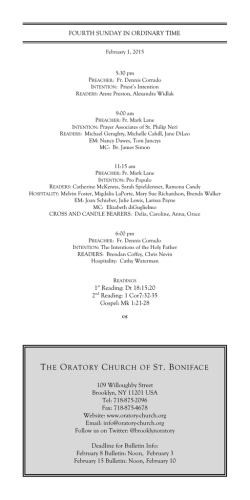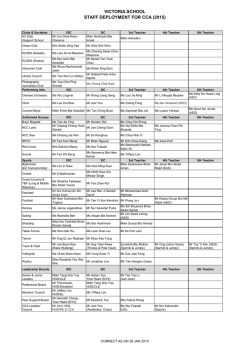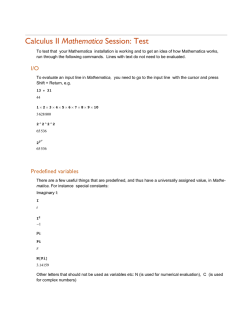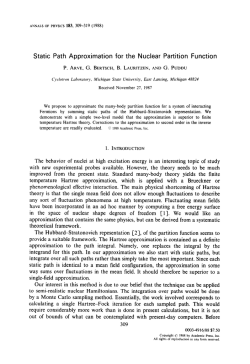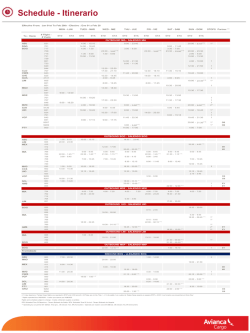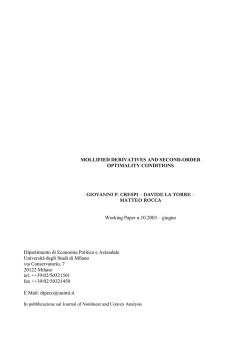
version of January 25, 2015
Definition of the Integral Calculus is built on two operations — differentiation, which is used to analyse instantaneous rate of change, and integration, which is used to analyse areas. In these notes, we define the integral. We’ll start with an example. We’ll find the area under the curve y = ex (and above the x–axis) for 0 ≤ x ≤ 1. That is, the area of (x, y) 0 ≤ y ≤ ex , 0 ≤ x ≤ 1 . In different applications this will have different interpretations — not just area. For example, if x is time and ex is your velocity at time x, then we’ll see later that the specified area is the total distance travelled between time 0 and time 1. After we finish with the example, we’ll mimic Rb it to give a general definition of the integral a f (x) dx. Example 1 In this example we’ll compute the area of (x, y) 0 ≤ y ≤ ex , 0 ≤ x ≤ 1 . Our strategy will be to approximate the area in question by the area of a union of a large number of very thin rectangles, which we can of course compute. As we take more and more rectangles we get better and better approximations. Taking the limit as the number of rectangles goes to infinity gives the exact area. Start by picking a natural number n and subdividing the interval 0 ≤ x ≤ 1 into n equal subintervals each of width 1/n, and subdivide the area of interest into corresponding thin strips, as in the figure below. The area we want is exactly the sum of the areas of all of the thin strips. y = ex y 1 n 2 n ··· n n x Each of these strips is almost, but not quite, a rectangle. The bottom is flat and is perpendicular to the sides, that are straight and parallel to each other. The only problem is that the top is not horizontal. So we shall approximate each strip by a rectangle, just by levelling off the top. But now we have to make a choice — at what height do we level off the top? Consider, for example, the leftmost strip. On this strip, x runs from 0 to 1/n. As x runs from 0 to 1/n, the height y runs from e0 to e1/n . It would be reasonable to choose the height of the approximating triangle to be somewhere between e0 and e1/n . Which height should we choose? Well actually it doesn’t matter. We shall shortly take the limit n → ∞ and, in c Joel Feldman. 2015. All rights reserved. 1 January 29, 2015 y = ex y e1/n0 e x 1 n that limit, all of those different choices give exactly the same final answer. We won’t justify that statement in this example, but there will be an (optional) section shortly that provides the justification. For this example we just, arbitrarily, choose the height of each rectangle to be the height of the graph y = ex at the smallest value of x in the corresponding strip. The figure on the left below shows the approximating rectangles when n = 4 and the figure on the right shows the approximating rectangles when n = 8. Now we compute the approximating y y x y = ex y=e 1 4 2 4 3 4 4 4 x 1 8 2 8 3 8 4 8 5 8 6 8 7 8 8 8 x area when there are n strips. We approximate the leftmost strip by a rectangle of height e0 . All of the rectangles have width 1/n. So the leftmost rectangle has area n1 e0 . On strip number 2, x runs from n1 to n2 . So the smallest value of x on strip number 2 is n1 , and we approximate strip number 2 by a rectangle of height e1/n and hence of area n1 e1/n . And so on. On the last to nn = 1. So the smallest value of x on the last strip is n−1 , and we strip, x runs from n−1 n n (n−1)/n 1 (n−1)/n and hence of area n e approximate the last strip by a rectangle of height e . The total area of all of the approximating rectangles is 1 (n−1)/n 1 0 1 1/n 1 2/n 1 3/n e + e + e + e +···+ e n n n n n 1 1 2 3 (n−1)/n 1 + e /n + e /n + e /n + · · · + e = n 1 = 1 + r + r 2 + · · · + r n−1 n Total approximating area = c Joel Feldman. 2015. All rights reserved. 2 (1) January 29, 2015 with r = e1/n . Fortunately there is a simple formula for the sum 1 + r + r 2 + · · · + r n−1 = rn − 1 r−1 if r 6= 1 (2) So now we’ll make a brief aside to derive (2). Let’s denote the sum of interest Sn−1 = 1 + r + r 2 + · · · + r n−1 . The derivation is based on the observation that when we multiply our sum by r, we get almost the same sum back again. rSn−1 = r 1 + r + r 2 + · · · + r n−1 = r + r2 + r3 + · · · + rn = Sn−1 − 1 + r n So rSn−1 = Sn−1 − 1 + r n , and, as long as r 6= 1, we can solve for Sn−1 . rSn−1 = Sn−1 − 1 + r n n =⇒ (r − 1)Sn−1 = r − 1 =⇒ Sn−1 rn − 1 = r−1 as desired. Now back to (1). Using (2) with r = e1/n , we have that, when we use n slices, n 1 rn − 1 1 (e1/n ) − 1 1 e−1 Total approximating area = = = 1/n n r−1 n e −1 n e1/n − 1 (3) To get the exact area all we need to do is make the approximation better and better by taking the limit n → ∞. The limit will look more familiar if we rename 1/n to X. As n tends to infinity, X tends to 0, so 1 e−1 n→∞ n e1/n − 1 1/n = (e − 1) lim 1/n n→∞ e −1 X = (e − 1) lim X X→0 e − 1 Exact area = lim (with X = 1/n) Frequently, limits of ratios can be evaluated simply by computing the limits of the numerator and denominator separately and then dividing. But that won’t work in this case, because both the numerator, X, and the denominator, eX − 1, converge to 0 as X → 0. One way X X −e0 to evaluate the limit1 is to observe that the limit of e X−1 = eX−0 as X → 0 is exactly the x definition of the derivative of e at x = 0. −1 −1 h i−1 eX − e0 d X X = lim = e = eX X=0 lim X X→0 X − 0 X→0 e − 1 dX X=0 (4) =1 1 Another way to evaluate the limit is to use l’Hˆopital’s rule, if you know it. If you don’t know l’Hˆopital’s rule, ignore this footnote. By l’Hˆopital’s rule, lim eXX−1 = lim e1X = 1. X→0 c Joel Feldman. 2015. All rights reserved. X→0 3 January 29, 2015 That’s it. Exact area = (e − 1) lim X =e−1 −1 X→0 eX Example 1 1. A More Careful Area Computation (Optional) In Example 1 we considered the area of the region (x, y) 0 ≤ y ≤ ex , 0 ≤ x ≤ 1 . We approximated that area by the area of a union of n thin rectangles. We then claimed that the exact area was the limit, as n → ∞, of the nth approximating area. We did not justify the claim. We are now going to justify that claim. We are going to carefully compute the exact area of the region 0 ≤ y ≤ ex , 0 ≤ x ≤ 1. There will be no uncontrolled approximations. d x e = ex is always positive, the function ex increases as x inBecause the derivative dx creases. Consequently, the smallest and largest values of ex on the interval a ≤ x ≤ b are ea and eb , respectively. In particular, for 0 ≤ x ≤ 1/n, ex takes values only between e0 and e1/n . As a result, the first strip (x, y) 0 ≤ x ≤ 1/n, 0 ≤ y ≤ ex • contains the rectangle of 0 ≤ x ≤ 1/n, 0 ≤ y ≤ e0 (the lighter rectangle in the figure on the left below) and • is contained in the rectangle 0 ≤ x ≤ 1/n, 0 ≤ y ≤ e1/n (the largest rectangle in the figure on the left below). Hence 1 1 1 0 e ≤ Area (x, y) 0 ≤ x ≤ 1/n, 0 ≤ y ≤ ex ≤ e /n n n y = ex y (5) y = ex y e2/n e1/n0 e e1/n0 e 1 n c Joel Feldman. 2015. All rights reserved. x 1 n 4 2 n ··· n n x January 29, 2015 Similarly, for the second, third, . . . , last strips, as in the figure on the right above, 1 1/n e ≤ Area (x, y) n 1 2/n e ≤ Area (x, y) n .. . 1 2/n e n 1 3 ≤ e /n n .. . 1/n ≤ x ≤ 2/n, 0 ≤ y ≤ ex ≤ 2/n ≤ x ≤ 3/n, 0 ≤ y ≤ ex 1 (n−1)/n e ≤ Area (x, y) n .. . (n−1)/n ≤ x ≤ n/n, 0 ≤ y ≤ ex ≤ 1 n/n e n Adding (5) and all of these lines together gives 1 (n−1)/n 1 1 + e /n + · · · + e n ≤ Area (x, y) 0 ≤ x ≤ 1, 0 ≤ y ≤ ex 1 1/n 2 n e + e /n + · · · + e /n ≤ n 1 1 1 (n−1)/n = e /n 1 + e /n + · · · + e n n n −1 , with r = e1/n , so that r n = e1/n = e, Using (2), i.e. 1 + r + · · · + r n−1 = rr−1 1 e−1 0 ≤ x ≤ 1, 0 ≤ y ≤ ex ≤ 1 e1/n e − 1 ≤ Area (x, y) 1/n ne −1 n e1/n − 1 Thus the exact area must be at least as large as the exact area must also be at least as large as 1 e−1 n e1/n −1 for every single integer n ≥ 1. So X 1 e−1 = (e − 1) lim =e−1 1/n X 1 n→∞ n e X= /n→0 e − 1 −1 lim by (4). Similarly, the exact area must be smaller than (or equal to) n1 e1/n e1e−1 for every /n −1 single natural number n. So the exact area must also be smaller than or equal to X X 1 1/n e − 1 e = (e − 1) lim eX X = (e − 1) lim eX lim X =e−1 1/n n→∞ n X→0 X→0 X→0 e − 1 e −1 e −1 lim We have now shown that e − 1 ≤ Area (x, y) 0 ≤ y ≤ ex , 0 ≤ x ≤ 1 ≤ e − 1 so that the area must be exactly e − 1. 2. Summation Notation The summation notation n X ai i=m c Joel Feldman. 2015. All rights reserved. 5 January 29, 2015 means am + am+1 + am+2 + · · · + an−1 + an For example 7 X 1 1 1 1 1 1 = + + + + i2 32 42 52 62 72 i=3 P Note that right hand side — which is the value of 7i=3 i12 — does not contain “i”. The summation index i is just a “dummy” variable and it does not have to be called i. For example 7 7 7 X X X 1 1 1 = = 2 2 i j ℓ2 i=3 j=3 ℓ=3 7 X 1 has no Also the summation index has no meaning outside the sum. For example i 2 i i=3 meaning. It is gibberish. Theorem 2 (Arithmetic of Summation Notation). Let n ≥ m be integers. Then for all real numbers c and ai , bi , m ≤ i ≤ n. n n P P (a) cai = c ai (b) i=m i=m n P (ai + bi ) = i=m (c) n P i=m (ai − bi ) = n P i=m n P i=m ai + ai − n P bi bi i=m n P i=m Proof. This theorem is proven by just writing out both sides of each equation, and observing that they are equal, by the usual laws of arithmetic. For example, for the first equation, the left hand side is n X cai = cam + cam+1 + · · · + can i=m and the right hand side is X n c ai = c(am + am+1 + · · · + an ) i=m They are equal by the usual distributive law. The “distributive law” is the fancy name for c(a + b) = ca + cb. c Joel Feldman. 2015. All rights reserved. 6 January 29, 2015 Not many sums can be “computed exactly”. Here are some that can. The first few are used a lot. Theorem 3. (a) n P , for all real numbers a and r 6= 1 and all integers n ≥ 0. ar i = a 1−r 1−r n P 1 = n, for all integers n ≥ 1. n P i = 21 n(n + 1), for all integers n ≥ 1. n P i2 = 16 n(n + 1)(2n + 1), for all integers n ≥ 1. i=0 (b) i=1 (c) i=1 (d) i=1 (e) n P i=1 n+1 i3 = h 1 n(n 2 i2 + 1) , for all integers n ≥ 1. Proof of Theorem 3 (Optional) Proof. (a) The first sum is n X i=0 ar i = ar 0 + ar 1 + ar 2 + · · · + ar n which is just the left hand side of (2), with n replaced by n + 1, multiplied by a. (b) The second sum is just n copies of 1 added together, so of course the sum is n. (c) We’ll derive the third sum using a trick that generalises to the fourth sum (and also to higher powers). The trick uses the “generating function” x + x2 + x3 + · · · + xn = x 1 + x + x2 + · · · + xn−1 xn − 1 =x x−1 xn+1 − x = x−1 (6) by (2) with r = x. The reason that this is called a generating function is that we can build the sum that we want out of the left hand side. Specifically, when we differentiate the left hand side and then take the limit x → 1 we get d x + x2 + x3 + · · · + xn = lim 1 + 2x + 3x2 + · · · + nxn−1 x→1 x→1 dx = 1+2+3+···+n lim c Joel Feldman. 2015. All rights reserved. 7 January 29, 2015 which is exactly the sum that we are trying to evaluate. So, by (6), d h xn+1 − x i 1 + 2 + 3 + · · · + n = lim x→1 dx x−1 h (n + 1)xn − 1(x − 1) − (xn+1 − x)1 i = lim x→1 (x − 1)2 h nxn+1 − (n + 1)xn + 1 i = lim x→1 (x − 1)2 Both the numerator and denominator of this ratio converge to zero as x tends to one. So, if you know l’Hˆopital’s rule, you can evaluate the limit by applying it twice. But here’s another evaluation that does not use l’Hˆopital’s rule. It is generally easier to see what’s going on as x approaches zero than it is to see what’s going on as x approaches some nonzero number. So let’s set x = 1 + h. Then sending x to 1 is equivalent to sending h to zero, and we have to compute h n(1 + h)n+1 − (n + 1)(1 + h)n + 1 i 1 + 2 + 3 + · · · + n = lim h→0 h2 Now imagine multiplying out (1 + h)n+1 and (1 + h)n . (This might be a good time to review the binomial theorem.) The constant term (i.e. the h0 term) in the numerator n(1 + h)n+1 − (n + 1)(1 + h)n + 1 is n × 1 − (n + 1) × 1 + 1 = 0 The h1 term in the numerator n(1 + h)n+1 − (n + 1)(1 + h)n + 1 is n × (n + 1)h − (n + 1) × nh + 0 = 0 The h2 term in the numerator n(1 + h)n+1 − (n + 1)(1 + h)n + 1 is n(n − 1) 2 n2 (n + 1) − n(n + 1)(n − 1) 2 (n + 1)n 2 h − (n + 1) × h + 0= h 2 2 2 (n + 1)[n2 − n(n − 1)] 2 h = 2 n(n + 1) 2 h = 2 All together, the numerator n× n(1 + h)n+1 − (n + 1)(1 + h)n + 1 = n(n + 1) 2 h + terms of degree at least 3 in h 2 so that the ratio n(n + 1) n(1 + h)n+1 − (n + 1)(1 + h)n + 1 = + terms of degree at least 1 in h 2 h 2 and the limit h n(1 + h)n+1 − (n + 1)(1 + h)n + 1 i n(n + 1) = 1 + 2 + 3 + · · · + n = lim h→0 h2 2 as desired. c Joel Feldman. 2015. All rights reserved. 8 January 29, 2015 (d) (e) The derivation of the fourth and fifth sums is similar to, but even more tedious than, that of the third sum. One takes two or three derivatives of the generating functional. 3. The Definition of the Definite Integral Rb In this section we give a definition of a f (x) dx, along the lines of Example 1. But first some terminology and a couple of remarks that motivate the definition. Rb • The symbol a f (x) dx is read “the (definite) integral of the function f (x) from a to Rb b”. The function f (x) is called the integrand of a f (x) dx and a and b are called the limits of integration. Rb • If f (x) ≥ 0 and a ≤ b, one interpretation of the symbol a f (x) dx is “the area of the region (x, y) a ≤ x ≤ b, 0 ≤ y ≤ f (x) ”. y = f (x) y a b x Rb • If a ≤ b, but f (x) is not always positive, one interpretation of the symbol a f (x) dx is “the signed area between y = f (x) and the x–axis for a ≤ x ≤ b”. For “signed area” (which is also called the “net area”), areas above the x–axis count as positive while areas below the x–axis count as negative. In the example below, we have the graph of the function −1 if 1 ≤ x ≤ 2 f (x) = 2 0 if 2 < x ≤ 4 otherwise The 2 × 2 shaded square above the x–axis has signed area +2 × 2 = +4. The 1 × 1 shaded square below the x–axis has signed area −1 × 1 = −1. So, for this f (x), Z 0 c Joel Feldman. 2015. All rights reserved. 5 f (x) dx = +4 − 1 = 3 9 January 29, 2015 y 2 signed area= +4 1 2 −1 x 4 signed area= −1 • We’ll come back to the case b < a later. Rb We’re now ready to define a f (x) dx. To do so we mimic what we did in Example 1, but replacing the function ex by a generic function f (x) and replacing the interval from 0 to 1 by the generic interval from a to b. We’ll eventually allow a and b to be any two real numbers, not even requiring a < b. But it will be easier on your brain to pretend for a while that a < b, and that’s what we’ll do. • We start by selecting any natural number n (we’ll eventually take the limit n → ∞) and subdividing the interval from a to b into n equal subintervals. Each subinterval . For each integer 1 ≤ i ≤ n, the final value of x on interval number i will has width b−a n b−a be xi = a + i n . In particular, on the first subinterval, x runs from a, which we’ll also . On the second subinterval, x runs from x1 to x2 = a + 2 b−a . call x0 , to x1 = a + b−a n n In general, on subinterval number i (with 1 ≤ i ≤ n), x runs from xi−1 to xi . y y = f (x) a = x0 x1 x2 x3 ··· xn−1 xn = b x • We’ll approximate f on each subinterval by its value at some point of the subinterval. That is, for each 1 ≤ i ≤ n, we’ll pick some x∗i,n between xi−1 and xi and we’ll approximate f (x), for all x between xi−1 and xi , by f (x∗i,n ). Geometrically, we’re approximating the part of the region between the curve y = f (x) and the x–axis that has x between xi−1 and xi by the rectangle (x, y) x is between xi−1 and xi , and y is between 0 and f (x∗i,n ) c Joel Feldman. 2015. All rights reserved. 10 January 29, 2015 f (x∗i,n ) xi−1 x∗i,n xi • So, when there are n subintervals our approximation to the (signed) area between the curve y = f (x) and the x–axis, with x running from a to b is n X f (x∗i,n ) i=1 b−a n • Finally we define the integral by taking the limit as n → ∞. Definition 4. Let a and b be two real numbers and let f (x) be a function that is defined for all x between a and b. Then we define Z b n X b−a f (x∗i,n ) f (x) dx = lim n→∞ n a i=1 when the limit exists and takes the same value for all choices of the x∗i,n ’s. In this case, we say that f is integrable on the interval from a to b. It turns out that any function f that is continuous, except possibly for a finite number of jump discontinuities, is integrable. We will not justify this statement. But a slightly weaker statement is justified in the following (optional) section. Note that, in Definition 4, we allow a and b to be any two real numbers. We do not Rb require that a < b. That is, even when a > b, the symbol a f (x) dx is still defined by the Rb formula of Definition 4. We’ll get an interpretation for a f (x) dx, when a > b, later. Rb It is important to note that the definite integral a f (x) dx represents a number, not a function of x. The integration variable x is another “dummy” variable, just like the P summation index i in ni=m ai . The integration variable does not have to be called x. For example Z Z Z b b f (x) dx = a b f (t) dt = a f (u) du a Just as with summation variables, the integration variable has no meaning outside of f (x) dx. For example Z Z 1 x ex dx x 0 c Joel Feldman. 2015. All rights reserved. ex dx and 0 11 January 29, 2015 are both gibberish. Here is some terminology associated with Definition 4 P P is called a Riemann sum. It is often written ni=1 f (x∗i ) ∆x. • The sum ni=1 f (x∗i,n ) b−a n , of the ith • If we choose each x∗i,n to be the left hand end point, xi−1 = a + (i − 1) b−a n interval, [xi−1 , xi ], we get the approximation n X b − a b − a f a + (i − 1) n n i=1 Rb which is called the “left Riemann sum approximation to a f (x) dx with n subintervals”. • Similarly, the approximation n X b − a b − a f a+i n n i=1 Rb is called the “right Riemann sum approximation to a f (x) dx with n subintervals”. Of course the word “right” signifies that, on each subinterval [xi−1 , xi ] we approximate , of the subinterval. f by its value at the right–hand end–point, xi = a + i b−a n • A third commonly used approximation is n X b − a b − a f a + (i − 0.5) n n i=1 Rb which is called the “midpoint Riemann sum approximation to a f (x) dx with n subintervals”. The word “midpoint” signifies that, on each subinterval [xi−1 , xi ] we approx, of the subinterval. imate f by its value at the midpoint, xi−12+xi = a + (i − 21 ) b−a n Example 5 We are now in a position to formulate the the area of (x, y) is Z 0 1 conclusion of Example 1 as: 0 ≤ y ≤ ex , 0 ≤ x ≤ 1 ex dx = e − 1 Example 5 Example 6 R1 Let’s pretend that we are interested in the integral 0 ex dx but that we don’t know how to evaluate it. We can still use the strategy behind Definition 4 to get approximate values for the integral, complete with bounds on the error introduced by the approximation. The reason is that, because the integrand f (x) = ex is an increasing function of x, we approximate f (x) on each subinterval xi−1 ≤ x ≤ xi c Joel Feldman. 2015. All rights reserved. 12 January 29, 2015 • by its smallest value on the subinterval, namely f (xi−i ), when we compute the left Riemann sum approximation and • by its largest value on the subinterval, namely f (xi ), when we compute the right Riemann sum approximation. This is illustrated in the two figures below. The shaded region in the left hand figure is the left Riemann sum approximation and the shaded region in the right hand figure is the right Riemann sum approximation. y = ex y 1 n 2 n ··· n n y = ex y x 1 n 2 n ··· n n x R1 P For the integral 0 ex dx the left Riemann sum approximation is ni=1 e(i−1)/n n1 and the P right Riemann sum approximation is ni=1 ei/n n1 . So Z 1 n n X X 1 i (i−1)/n 1 x ≤ e dx ≤ e /n e n n 0 i=1 i=1 P Thus Ln = ni=1 e(i−1)/n n1 , which for any n can be evaluated by computer, is a lower bound R1 P on the exact value of 0 ex dx and Rn = ni=1 ei/n n1 , which for any n can also be evaluated by R1 computer, is an upper bound on the exact value of 0 ex dx. For example, when n = 1000, Ln = 1.7174 and Rn = 1.7191 (both to four decimal places) so that, again to four decimal places, Z 1 1.7174 ≤ ex dx ≤ 1.7191 0 Example 6 Example 7 Rb The integral a dx (i.e. the integrand f (x) = 1) is the area of the shaded rectangle in the figure on the right below. So y Z a 1 b dx = b − a a c Joel Feldman. 2015. All rights reserved. 13 b x January 29, 2015 Example 7 Example 8 Rb Let b > 0. The integral 0 x dx is the area of the shaded triangle (of base b and of height b) in the figure on the right below. So Z b x dx = 0 y=x y b b2 2 b x R0 The integral −b x dx is the signed area of the shaded triangle (again of base b and of height b) in the figure on the right below. So y −b Z 0 −b x 2 x dx = − b 2 y=x −b Example 8 Example 9 R1 The integral −1 1 − |x| dx is the area of the shaded triangle (of base 2 and of height 1) in the figure on the right below. So y 1 1 1 1 − |x| dx = × 2 × 1 = 1 2 −1 Z −1 1 x Example 9 Example 10 √ R1√ The integral 0 1 − x2 dx has integrand f (x) = 1 − x2 . So it represents the area under c Joel Feldman. 2015. All rights reserved. 14 January 29, 2015 √ √ y = 1 − x2 with x running from 0 to 1. But we may rewrite y = 1 − x2 as x2 + y 2 = 1, y ≥ 0, so the integral is the area of the quarter circle in the figure on the right below. So Z 1 0 √ π 1 1 − x2 dx = π(1)2 = 4 4 y 1 1 x Example 10 Example 11 Rπ The integral −π sin x dx is the signed area of the shaded region in the figure on the right below. The part of the shaded region below the x–axis is exactly the reflection, in the x–axis, of the part of the shaded region above the x–axis. So the signed area of part of the shaded region below the x–axis is the negative of the signed area of part of the shaded region above the x–axis and y 1 Z π sin x dx = 0 −π π x −π −1 Example 11 Example 12 Suppose that a particle is moving along the x–axis and suppose that at time t its velocity is v(t) (with v(t) > 0 indicating rightward motion and v(t) < 0 indicating leftward motion). What is the change in its x–coordinate between time a and time b > a? We’ll work this out using a procedure similar to our definition of the integral. First pick a natural number n. As usual, we will eventually take the limit n → ∞. Divide the time interval from a to b into n equal subintervals, each of width b−a . n • The first time interval runs from a to a + b−a . Because we are going to take the limit n b−a n → ∞, so that n → 0, we can think of the velocity during the first subinterval as being essentially constant at v(a). So during the first subinterval the particle travels, essentially, at constant velocity v(a) for b−a units of time, and its x–coordinate changes n b−a by v(a) n . c Joel Feldman. 2015. All rights reserved. 15 January 29, 2015 to time a + 2 b−a . Again, we • Similarly, the second interval runs from time a + b−a n n can think of the velocity during the second subinterval as being essentially constant at v a + b−a . So during the second subinterval the particle’s x–coordinate changes n b−a . essentially, by v a + b−a n n to a + i b−a and during • In general, time subinterval number i runs from a + (i − 1) b−a n n b−a this subinterval the particle’s x–coordinate changes, essentially, by v a+(i−1) b−a . n n So the net change in x–coordinate from time a to time b is essentially b − a b − a b − a b − a b−a +v a+ + · · · + v a + (i − 1) +··· v(a) n n n n n b − a b − a + v a + (n − 1) n n n X b−a b−a = v a + (i − 1) n n i=1 This exactly the left Riemann sum approximation to the integral of v from a to b with Rb n subintervals. The limit as n → ∞ is exactly the definite integral a v(t) dt. Following tradition, we have called the (dummy) integration variable t rather than x to remind us that it is time that is running from a to b. The conclusion of the above discussion is that if a particle is moving along the x–axis and its x–coordinate and velocity at time t are x(t) and v(t), respectively, then, for all b > a, Z b x(b) − x(a) = v(t) dt a Example 12 It is generally tiresome in the extreme to actually evaluate an integral directly using the definition. Fortunately, in practice, one virtually never has to do so. 4. Careful Definition of the Integral (Optional) In this (optional) section we give a more mathematically rigorous definition of the definite Rb integral a f (x) dx. Some textbooks use a sneakier, but equivalent, definition. The integral will be defined as the limit of a family of approximations to the area between the graph of y = f (x) and the x–axis, with x running from a to b. To form these approximations, we select an integer n, and subdivide the interval from a to b into n subintervals by selecting n + 1 values of x that obey a = x0 < x1 < x2 < · · · < xn−1 < xn = b The subinterval number j runs from xj−1 to xj . We also select n more values of x, denoted x∗1 , x∗2 , · · · , x∗n , that obey xj−1 ≤ x∗j ≤ xj c Joel Feldman. 2015. All rights reserved. for all 1 ≤ j ≤ n 16 January 29, 2015 That is, x∗j must be in interval number j. The area between the graph of y = f (x) and the R xj x–axis, with x running from xj−1 to xj , i.e. the contribution, xj−1 f (x) dx, from interval y y = f (x) a = x0 x1 x2 x3 ··· xn−1 xn = b x number j to the integral, is approximated by the area of a rectangle. The rectangle has width xj − xj−1 and height f (x∗j ). f (x∗j ) xj−1 x∗j xj Thus the approximation to the integral, using all subintervals, is Z b f (x) dx ≈ f (x∗1 )[x1 − x0 ] + f (x∗2 )[x2 − x1 ] + · · · + f (x∗n )[xn − xn−1 ] a Of course every different choice of P = n, x1 , x2 , · · · , xn−1 , x∗1 , x∗2 , · · · , x∗n gives a different approximation that we’ll call I(P) = f (x∗1 )[x1 − x0 ] + f (x∗2 )[x2 − x1 ] + · · · + f (x∗n )[xn − xn−1 ] But we claim that, for any reasonable (we’ll be more precise about this shortly) function f (x), if you take any sequence of these approximations, with the maximum width of the rectangles tending to zero, you always get exactly the same limiting value. This limiting Rb value is defined to be a f (x) dx. If we denote by M(P) = max x1 − x0 , x2 − x1 , · · · , xn − xn−1 the maximum width of the rectangles used in the approximation determined by P, then the definition of the definite integral is Z b f (x) dx = lim I(P) M (P)→0 a c Joel Feldman. 2015. All rights reserved. 17 January 29, 2015 For the rest of this section, assume that f (x) is continuous for a ≤ x ≤ b, is differentiable for all a < x < b and that |f ′(x)| ≤ F , for some constant F . We will now show that, under these hypotheses, as M(P) approachs zero, I(P) always approaches the area, A, between the graph of y = f (x) and the x–axis, with x running from a to b. These assumptions are chosen to make the argument particularly transparent. With a little more work one can weaken the hypotheses considerably. We are cheating a little by implicitly assuming that the area A exists. In fact, one can adjust the argument below to remove this implicit assumption. Concentrate on Aj , the part of the area coming from xj−1 ≤ x ≤ xj . We have approxif (xj ) f (x∗j ) f (xj ) Aj xj−1 xj xj−1 x∗j xj mated this area by f (x∗j )[xj − xj−1 ]. Let f (xj ) and f (xj ) be the largest and smallest values2 of f (x) for xj−1 ≤ x ≤ xj . The true area Aj has to lie somewhere between f (xj )[xj − xj−1 ] and f (xj )[xj − xj−1 ]. As f (xj )[xj − xj−1 ] ≤ Aj ≤ f (xj )[xj − xj−1 ] f (xj )[xj − xj−1 ] ≤ f (x∗j )[xj − xj−1 ] ≤ f (xj )[xj − xj−1 ] both Aj and f (x∗j )[xj −xj−1 ] lie between f (xj )[xj −xj−1 ] and f (xj )[xj −xj−1 ], and the distance between Aj and f (x∗j )[xj − xj−1 ] is no more than the distance between f (xj )[xj − xj−1 ] and f (xj )[xj − xj−1 ], which is [f (xj ) − f (xj )][xj − xj−1 ]. Thus the error in this part of our approximation obeys Aj − f (x∗ )[xj − xj−1 ] ≤ [f (xj ) − f (xj )][xj − xj−1 ] j By the Mean–Value Theorem, there exists a c between xj and xj such that f (xj ) − f (xj ) = f ′ (c)[xj − xj ] By the assumption that |f ′ (x)| ≤ F for all x and the fact that xj and xj must both be between xj−1 and xj f (xj ) − f (xj ) ≤ F xj − xj ≤ F [xj − xj−1 ] Hence the error in this part of our approximation obeys Aj − f (x∗j )[xj − xj−1 ] ≤ F [xj − xj−1 ]2 2 Here we are using the fact, that we’ll not justify, that for any continuous function f (x), there are xj−1 ≤ xj , xj ≤ xj such that f (xj ) ≤ f (x) ≤ f (xj ) for all xj−1 ≤ x ≤ xj . c Joel Feldman. 2015. All rights reserved. 18 January 29, 2015 and the total error obeys n n X X ∗ ∗ A − I(P) = A − A − f (x )[x − x ] ≤ f (x )[x − x ] j j j−1 j j−1 j j j=1 j=1 ≤ n X F [xj − xj−1 ]2 = ≤ n X F M(P) [xj − xj−1 ] = F M(P) j=1 j=1 n X j=1 F [xj − xj−1 ] [xj − xj−1 ] n X j=1 [xj − xj−1 ] = F M(P) (b − a) Since a, b and F are fixed, this tends to zero as the maximum rectangle width M(P) tends to zero. Thus, we have proven Theorem 13. Assume that f (x) is continuous for a ≤ x ≤ b, and is differentiable for all a < x < b with |f ′ (x)| ≤ F , for some constant F . Then, as the maximum rectangle width M(P) tends to zero, I(P) always converges to A, the area between the graph of y = f (x) and the x–axis, with x running from a to b. c Joel Feldman. 2015. All rights reserved. 19 January 29, 2015
© Copyright 2025
